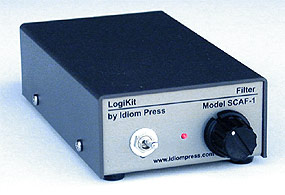SCAF-1 Questions & Answers
 SCAF-1 Questions & Answers.
SCAF-1 Questions & Answers.
SCAF-1 Noise Filter Frequently Asked Questions.
Q – Why is there no headphone jack on the front panel?
A – The designer of the layout of the unit – that’s me – does not like cords all over the operating position. Most operators typically place the SCAF-1 filter on top of their transceiver. Putting a headphone cord to that point would have the cord draped right across the front of the transceiver. Bad. Ugly.
Q – I see several people complaining on the Internet that the SCAF-1 does little or nothing for them.
Yes, that is entirely possible if they own an expensive and well designed modern radio with a complete set of crystal filters and passband tuning. There are a few – very few – radios offered that actually control the audio passband so that it does not pass through white noise and hiss, or any audio above the high side of the crystal filter they are using. This is how any better radio should be designed. But if the radio does not feature such control, and very few do, the SCAF-1 filter will give you that control – that is part of what the SCAF-1 filter does. If the radio already has that design feature, and an excellent set of crystal filters with variable passband tuning, then the SCAF-1 may not bring as much to the party.
That said, a lot of very highly respected CW operators prefer to operate with a relatively wide crystal filter, say 500 – 800 hertz bandwidth, and use a SCAF-1 to further shape the received passband. The virtual elimination of hiss and white noise, coupled with the absence of ringing in the SCAF-1 compared to narrow CW filters make the wide crystal filter and SCAF-1 combo hard to beat for most CW operation. And the improvement in tone of most CW monitors is a nice bonus.
Q – Well, I have an expensive radio and I want the best performance I can get. How can I tell if the SCAF-1 will help me?
A – Even some radios that cost over $3,000 are helped considerably by the SCAF-1. If you listen to your receiver and can hear hiss and white noise above the crystal filter passband cutoff frequency, then SCAF-1 will delight you. If you can’t hear it then the SCAF-1 will probably do little for you. Note that the demo .wav files on our site are honest and accurate.
Q – I primarily operate SSB. Should I buy the SCAF-1?
A – Well, let me be honest. The SCAF-1 was designed by a fellow who primarily operates CW. If you only operate SSB, it may well be that some of the DSP based filters might give you more bang for your buck. But at the same time we get reports of people who cascade the SCAF-1 and an audio DSP for SSB reception and love both of them. And there are users who use the SCAF-1 only for SSB and who are delighted with the performance. And in the mean time, most DSP filters are not terribly useful on CW.
Q – Why is one output jack for 3.5 mm headphone jacks, and the other for 1/4″ jacks?
A – More and more operators have switched from large headsets with big earcups to small “entertainment” headsets such as the “Walkman” type, which use 3.5 mm stereo plugs. This includes me, the designer. Most headphones in use these days are designed for full fidelity, up to and past 20,000 hertz. But the communications audio we listen to from our transceivers is never above about 3,000 hertz, even though many radios put out audio noise up to as much as 8 kHz. Such headsets are very good at passing through to the listener the white noise from the radio above that frequency, as well as other unpleasant sounds such as line noise that fall within the crystal filters but are above the station you are trying to copy. This is where the SCAF-1 is really a huge help.
Q – Why doesn’t the SCAF-1 disconnect a speaker when the headset is plugged in?
A – We gave considerable thought to this before not including such a provision. There were several reasons. For one, the long term reliability of the switching circuit of switching headphone jacks is terrible. For another, because we do not know what size plug the user will want to use, we don’t know which jack would have the switch. So we decided to not include it at all.
Got a question not answered here? Please Contact Us!




 Webmaster NØUN
Webmaster NØUN